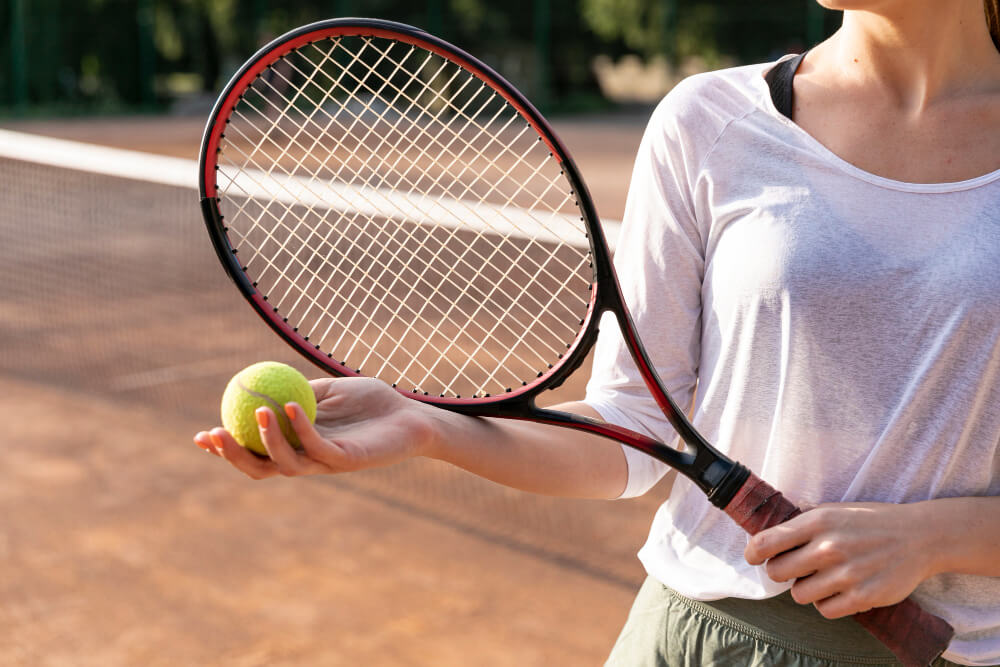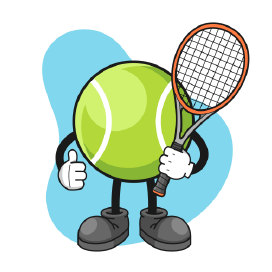If you’ve ever picked up a racket and hit a few balls, you’ll know the importance of having a good connection with your equipment. The feel of the grip in hand and the weight balance of the frame and strings all influence how well performs on the court. Of all these elements, it’s arguably the string pattern that makes or breaks your game.
From playing conditions to power potential – this right here is what determines performance above all else. But just how much does it matter? In this blog post today, we’ll explore what role string patterns play in elevating one’s game, uncovering exactly why they are so indispensable when aiming for success out there on the court!
Understanding the Importance of String Pattern in Tennis Rackets
The string pattern of a tennis racket is of paramount importance to the game. With the right spacing and tension, players can maximize their ball spin and control while also reducing tension around their wrists and shoulder.
String patterns provide players with power, accuracy and response as well as allowing for increased string stability over a longer period of time. No matter what your playing style is, having an understanding of string pattern and how it affects your racquet performance is essential when constructing an ideal racket setup. It’s important to consider this during your next restring or if you’re considering a new frame altogether; something as subtle as a one-millimeter difference in your grommet spacing has the potential to make or break your performance on the court.
How the String Pattern of a Tennis Racket Can Enhance Your Game?
Using a tennis racket with the right string pattern can vastly improve your game, allowing you to become an even better player. String pattern refers to the number of main strings and cross strings in the head of your racket – for instance, an 18×20 string pattern will have 18 main strings running horizontally and 20 cross strings running vertically. Depending on how tightly strung or loose a tennis racket is and what type of string used, it can have drastically different effects on your game. A tighter string pattern will provide more control while a looser one will offer more power. When selecting your string pattern, make sure that it fits your playing style so you can maximize each stroke’s efficacy. Once you figure out which combination works best for you, you may find yourself winning more matches in no time!
The Role of String Pattern in Power, Control, and Spin in Tennis
Understanding how string patterns can impact power, control, and spin in tennis is a critical part of maximizing performance. Players will often experiment with different string patterns to find the one that works best for them and their playing style. The power of a stroke comes from the combination of tension, gauge, and pattern. Increasing the tension can generate more power, but is limited by the player’s swing speed. Heavier gauge strings offer a greater degree of control at the expense of feel while thinner gauge strings provide more feel but decrease overall control. Finally, the pattern of the strings plays an equally important role in power and control; some patterns will allow for additional snapback off the racquet head, resulting in extra spin on shots. Tennis players should take all these factors into account when selecting their string pattern for optimal performance on court.
How Different String Patterns Affect the Sweet Spot of a Tennis Racket?
The sweet spot of a tennis racket has a great deal to do with the string pattern you choose. Generally, more strings in the pattern and tighter spacing lead to increased power and control. If the rigidity is too tight, however, it can have an adverse effect on control, often resulting in reduced comfort as well. To ensure that you hit your sweet spot every time, there is no single universally satisfactory string pattern; each player must experiment to find out what works best for them. Of course, this doesn’t mean you have to go it alone; the professionals at your local sporting goods store are always available to provide guidance.

Exploring the Impact of String Tension and String Gauge on Tennis Racket Performance
Tennis players are always looking for that extra edge when it comes to their playing performance. While careful practice, good footwork, and solid technique all come into play, small adjustments to a racket can also greatly impact its performance. String tension and string gauge are two key factors that can impact the power, spin, and control of a tennis racket. By adjusting these variables a player can fine-tune their game to match the style of play they prefer while seeing more consistent results. Experimenting with various strings and gauges is one of the best ways for a player to find the perfect balance that works best for them.
The Relationship Between String Pattern and Comfort in Tennis Rackets
An often overlooked area of tennis racket design is the strings. Finding a string with the right pattern for your game can make all the difference in how comfortable and successful you are on the court. The spacing, tautness, and composition of the strings will affect how the mains and crosses interact during play. Generally speaking, wider string patterns produce less spin while tighter patterns tend to generate more. Additionally, strings made up of higher-grade materials provide better control and durability than lower grade varieties. The tricky part is finding a balance between spin and control so that you’re still able to execute shots without feeling uncomfortable or having your racket give out too quickly. Consequently, combing through rackets and considering their respective string patterns should be one of top priorities when looking for a new racket because it goes a long way toward ensuring an enjoyable playing experience.
The Effect of String Pattern on the Feel and Touch of a Tennis Racket
When playing tennis, the feel and touch of a racket can make all the difference between a good and bad experience. Racket manufacturers take this into account by offering different string patterns for players to choose from, as each variation can completely change how a player interacts with and feels their racket during play. While some players prefer the tighter control that comes with a denser string pattern, others enjoy more power at the cost of less precision offered by an open pattern. Choosing the right string pattern to match one’s style of play is essential in ensuring that not only is the control there when needed, but also to create an optimal blend of touch, power and feel with each shot. For any keen tennis enthusiast, understanding how each type of string pattern helps shape their experience on court could be just what they need to improve their game.
How Changing Your Tennis Racket’s String Pattern Can Improve Your Overall Performance?
Changing the string pattern of your tennis racket can have a dramatic effect on your overall performance in the game. Different pattern configurations provide varying amounts of power, spin, shock absorption and control from your hits, meaning altering this component can have a positive effect on how you serve, volleys and return shots to your opponent.
Furthermore, using various string patterns allows players to amp up their game during certain points or matches when desired; more open patterns will enable a player to hit with greater power, for example. Likewise, different tensions of strings also impact a player’s game by influencing ball speed, spin rate and durability over time. Ultimately, by properly selecting the right combination of string pattern and tension tailored to your individual playing style and court conditions it is possible to improve significantly your overall performance with each stroke you make in the game.

What is the difference between 18×20 and 16×19 string pattern?
The main difference between an 18×20 and a 16×19 string pattern lies in the number of vertical and horizontal strings present. An 18×20 string pattern has 18 vertically strung main strings, as well as 20 horizontally strung crosses or “intermediates” along the outer edges of the frame. Conversely, a 16×19 string pattern consists of 16 main strings and 19 crosses. As a result of their different composition, an 18×20 string pattern provides more power when hitting shots than its 16×19 counterpart, due to having two fewer mains. This leads to a larger sweetspot and higher levels of forgiveness on off-center shots – making it preferred by many players with competitive aspirations.
What is the difference between 16×18 and 16×19 string pattern?
Tennis racquets come in various sizes and string patterns, but two common string patterns are 16×18 and 16×19. The difference between the two is very simple – 16×18 is a tighter string pattern that allows for more spin and control, whereas 16×19 has a larger gap between the strings resulting in less spin and control. However, 16×19 also offers players with more power and gives a softer feel on shots due to the wider spacing of strings allowing for better shock absorption. If you’re playing at a higher level, then it might be worth considering which string pattern will allow you to perform best because choosing the right one could have a positive effect on your game.
What is the impact of string pattern?
The impact of string pattern is far-reaching, particularly when it comes to sport such as tennis and squash. String pattern influences a player’s control, spin, power and feel when they hit the ball. Choosing the wrong string pattern can detrimentally affect performance during a match, while selecting the right one can make all the difference in terms of confidence and skills on the court. The way that strings are woven across the racket head affects how energy is tilted in different directions. The type and size of holes available also affects a player’s ability to utilize power and spin in their shots. Understanding the effects of string pattern can be fundamental for players looking to maximize their potential during a match.

What is the best string pattern for a tennis racket?
For many, the best string pattern for a tennis racket is subjective based on individual preference and playing style. There are four main string patterns: dense, open, hybrid and custom. A dense string pattern has reduced spacing between the strings which reduces the size of the sweet spot but provides more control in addition to increased power. An open string pattern increases the size of the sweet spot so the ball is less likely to veer off course with less precise shots, yet sacrifices power and control. For those who don’t prefer either extreme, a hybrid pattern might be best as it tends to combine elements of both dense and open patterns. Lastly, there are custom options available depending on a player’s needs allowing them to mix and match elements of different patterns. Ultimately, deciding upon the best string pattern will likely depend on an individual’s skill level, goals and playing style.
What is Federer string pattern?
Roger Federer is one of the most well-known tennis players in the world, and the string pattern of his racquet has become almost as famous. The Federer string pattern is a 16×19 setup, which means that for every sixteen mains (vertical strings), there are nineteen crosses (horizontal strings). This open pattern gives Federer a lot of freedom to hit powerful shots with spin as it has more space between each string that helps add more power and additional spin. This string formation allows for greater range on groundstrokes and volleys, making it ideal for an offensive style like Roger’s. It has certainly played a part in helping him win some of his incredible records, including 20 Grand Slams!
In conclusion
Understanding string patterns in tennis rackets is essential to enhance your game and get the most out of your racket. Different string patterns provide different levels of power, control, and spin; while they also affect the size and location of a racket’s sweet spot.
Additionally, different string gauges and tensions can have an effect on the feel, comfort, and touch of your racket when playing. All these factors should be taken into account when choosing a suitable string pattern for your racket. Choosing the right string pattern can help you improve your overall performance on the court and give you an edge over other opponents. While figuring out what string pattern works best for you may take some time and research to determine, it will definitely be worth it in the end!





